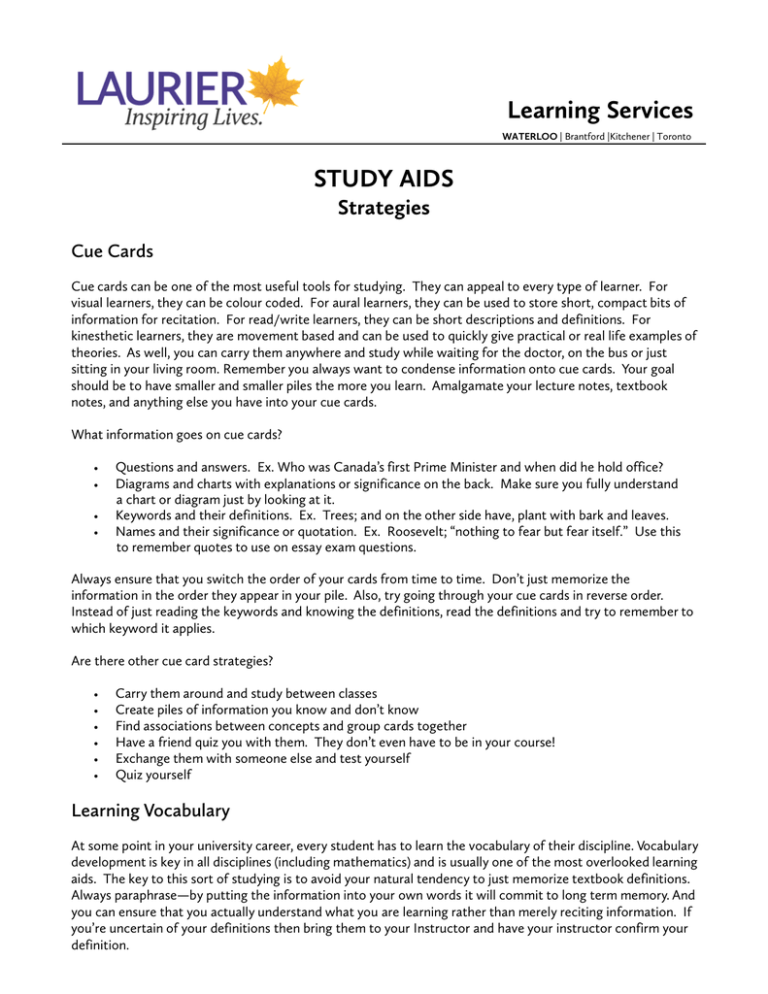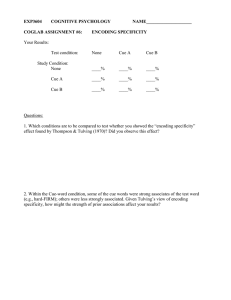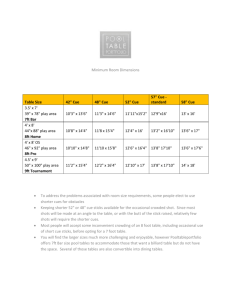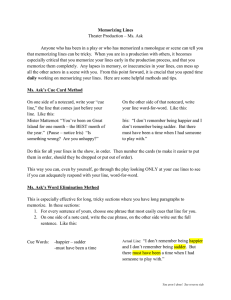Learning Services STUDY AIDS Strategies
advertisement

Learning Services WATERLOO | Brantford |Kitchener | Toronto STUDY AIDS Strategies Cue Cards Cue cards can be one of the most useful tools for studying. They can appeal to every type of learner. For visual learners, they can be colour coded. For aural learners, they can be used to store short, compact bits of information for recitation. For read/write learners, they can be short descriptions and definitions. For kinesthetic learners, they are movement based and can be used to quickly give practical or real life examples of theories. As well, you can carry them anywhere and study while waiting for the doctor, on the bus or just sitting in your living room. Remember you always want to condense information onto cue cards. Your goal should be to have smaller and smaller piles the more you learn. Amalgamate your lecture notes, textbook notes, and anything else you have into your cue cards. What information goes on cue cards? • • • • Questions and answers. Ex. Who was Canada’s first Prime Minister and when did he hold office? Diagrams and charts with explanations or significance on the back. Make sure you fully understand a chart or diagram just by looking at it. Keywords and their definitions. Ex. Trees; and on the other side have, plant with bark and leaves. Names and their significance or quotation. Ex. Roosevelt; “nothing to fear but fear itself.” Use this to remember quotes to use on essay exam questions. Always ensure that you switch the order of your cards from time to time. Don’t just memorize the information in the order they appear in your pile. Also, try going through your cue cards in reverse order. Instead of just reading the keywords and knowing the definitions, read the definitions and try to remember to which keyword it applies. Are there other cue card strategies? • • • • • • Carry them around and study between classes Create piles of information you know and don’t know Find associations between concepts and group cards together Have a friend quiz you with them. They don’t even have to be in your course! Exchange them with someone else and test yourself Quiz yourself Learning Vocabulary At some point in your university career, every student has to learn the vocabulary of their discipline. Vocabulary development is key in all disciplines (including mathematics) and is usually one of the most overlooked learning aids. The key to this sort of studying is to avoid your natural tendency to just memorize textbook definitions. Always paraphrase—by putting the information into your own words it will commit to long term memory. And you can ensure that you actually understand what you are learning rather than merely reciting information. If you’re uncertain of your definitions then bring them to your Instructor and have your instructor confirm your definition. There are many different ways to learn vocabulary. Aforementioned cue cards are a great tool, but those don’t work for everyone. Find what works best for you, whether it be cue cards, or listing them off a page, or explaining them in groups. Another good strategy for learning vocabulary is to create analogies between the topic of your definition and an unrelated item. For example, earlier in this chapter you learnt that you should take breaks while studying. Why? Because your mind is similar to a funnel. If you fill your mind up with knowledge too quickly the knowledge won’t have time to commit to long term memory This is similar (or analogous) to water and a funnel. If you fill a container (your brain) too quickly with water (knowledge) using a funnel (learning) the water will over flow and spill on the ground. However, if you stop every so often for 10 minutes you allow the water to properly enter the container. Memory Techniques One of the hardest tasks students have is learning how to remember what they have learnt for their exams. Generally, students study in one particular fashion: they read their notes over and over, sometimes writing them out again. This strategy works for read/write learners, but isn’t adequate for other learners. There many different ways to memorize information if you are struggling to recall what you have learnt come exam time. Mnemonics are simple memorization techniques using words that come in a variety of forms. Acronyms • Use an acronym to remember a group of terms or words. Ex. If you have to memorize the five great lakes (Huron, Ontario, Michigan, Erie, Superior), you can condense it to HOMES and just remember that five letter key to trigger your memory. Acrostic • Acrostics work much the same way as acronyms, but use the letters to form sentences, which may be easier for you to remember. Ex. You have to remember the planets, Mercury, Venus, Earth, Mars, Jupiter, Saturn, Uranus, Neptune. You can turn the first letter into a sentence: My very evil mother jumped safely under Ned. You can come up with your own and try to make it as memorable as possible. Rhyming • Rhymes will also stick in your mind much more readily than large chunks of information. Ex. In 1492 Columbus sailed the ocean blue. Songs • Create a song to a tune you already know and just softly sing it to yourself during the exam. Preferably in your own head! This can be a great way to remember a lot of information very easily. For example, most Ontarians remember the “Pizza Pizza” jingle Association • Associate information with objects or themes inside your head. You can associate them with visual pictures, or a story, or even colours, whatever works for you. This can be in several different forms. Ex. If you have to remember a series of terms, you can associate them with a series of items in your room. During the exam, just visualize walking around your room and then remember each term as you see each object. Or, you can create a story around the terms, the more absurd the better, and recite that story to yourself on the exam. Or, you can use letter associations to create memory triggers. For example Arteries move blood Away from your heart.





